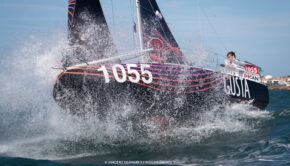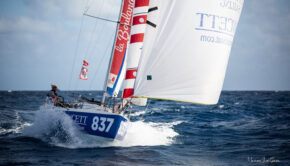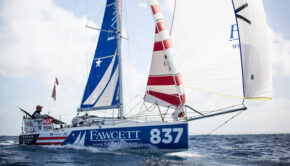A unique journey into solitude
Published on September 16th, 2019
The 22nd edition of the Mini-Transat La Boulangère sets sail on September 22 in which 87 women and men commence this biennial solo transatlantic competition in the Mini 6.50, a powered-up 21-footer that offers a supreme test for both boat and skipper.
The Mini 6.50 Class encourages competition in two divisions: the prototypes and the production boats.
Production boats are built out of fiberglass, have alloy masts, 1.6 meter draft, and prohibit material such as titanium, carbon fiber, and epoxy resin. Ten boats must have been built to qualify as an official production boat.
Prototypes, on their side, are free of these restrictions and have been, for years, the very first laboratory for sailing innovations. Canting keels, daggerboards, swinging wing masts, long poles for huge spinnakers, have been tried first on minis. New hull shapes with very wide waterlines and foils are the now the latest innovations.
But regardless of division, the Mini-Transat is a unique journey into solitude, with virtually no means of communication. In a world where communication and the instantaneous circulation of news are a constant, the fundamentals of this Mini 6.50 race have remained unchanged since the first edition in 1977.
Aboard this powered-up 21-footer there are no computers, no satellite links, no live media link-ups, no photo and video sends. It’s impossible to contact your loved ones to share the magical moments or try to get over a touch of the blues.
The only link with the shore is a daily report broadcast over SSB radio by race management to give the low-down on the weather situation, the 48-hour weather forecast, and the distances to the goal for each competitor. And while the sailors have the opportunity to communicate between one another via VHF, that is even restricted due to its limited range (around 10 miles).
Among the two-leg course (see below), the first leg (La Rochelle/Las Palmas de Gran Canaria) offers frequent exchanges among the majority of the competitors. However, things become more complicated during the second leg to Martinique. Indeed, as the competitors spread out across the Atlantic, the exchanges become few and far between. If they’re not sailing within a group, the racers can spend days, weeks even, without uttering a single word.
The Mini-Transat requires a lot of mental strength, otherwise you crumble. “It’s an emotional yoyo, you feel like you’re three years old,” smiles Céline Sallès (514). “In the Mini, you can be blubbering and laughing in the space of 10 minutes,” confirms Sébastien Guého (909). “Thanks to the demanding qualification system, we all arrive here mentally armed to make the passage. You just have to trust yourself.”
For some, the solitude and the lack of communication can prove to be a real challenge, particularly for the 76 rookies competing this year, like Matthieu Perraut (825).
“This is the toughest aspect of the Mini-Transat for me,” notes Perraut. “I’m not a through-and-through solo sailor, even though I like the idea of being the sole master of my ship. Mentally, it’s not easy to spend long periods without talking. Nobody sensible subjects themselves to such isolation. That said, it’s very interesting to confront such an experience and I’ve already learnt a lot about myself thanks to the Mini.”
For others, the solitude, in contact with the elements, is happiness itself, indeed it’s why they take part in the Mini-Transat. “This experience of solitude enables you to refocus on what’s important in life,” beams Jean-René Guilloux (915). “At 45, I’m at a point in my life where I can look back at what I’ve done, what successes I’ve had and what I haven’t yet had the time to do.”
The Mini-Transat is also the opportunity to grant yourself some quality time that you just don’t get every day, as Jean Lorre (570) explains: “In my Mini, I read books, I think, I talk out loud, I sing, I listen to music and to podcasts especially. I have time to think without being disturbed by some kind of interaction or notification from a social network.”
Benjamin Ferré refers to the Mini-Transat as an “extraordinary journey into your inner self,” a sentiment echoed by many that aspire for the enjoyment of what is surely the ultimate experience when it comes to a true sense of freedom, something that particularly appeals to Céline Sallès: “You leave all your problems on land. It’s just us, our boat and the ocean…”
Arnaud Machado forced to remain dockside
Arnaud Machado (910), as one of the favourites in the production boat category, fell of his bike a few days ago, fracturing his tibia, ending his second attempt at the Mini-Transat. “I’m bitterly disappointed. I wasn’t expecting that two years of preparation and sacrifice could fall through in a couple of minutes, especially as I was avoiding taking any risks as we neared the start. It’s a cruel twist of fate. I’m going to do all I can to start a programme of rehabilitation as quickly as possible so I’m ready for action again early next year.”
Event details – Entry list – Facebook
The first leg begins September 22 from La Rochelle, France and extends 1350 nm to Las Palmas de Gran Canaria. After an often complicated exit of the Bay of Biscay, sailors will expect some long slips down the Portuguese coast before arriving after 7 to 10 days in the Canary archipelago.
The second leg will start November 1 from Las Palmas de Gran Canaria and will take from 15 to 20 sailing days to complete the 2700 nm course and reach Le Marin in Martinique, French West Indies. Due to the numerous islands, the restart from the Canary can be tricky before reaching the famous trade winds that offer a long downwind run.
Source: Effetsmer









 We’ll keep your information safe.
We’ll keep your information safe.